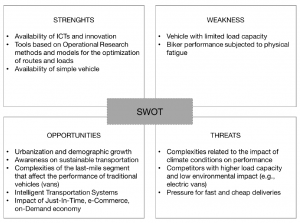Parcel delivery has been subject to significant paradigm shifts over recent decades, caused by urbanization. The economic development in the mid-1990s led to the rise of faster-growing medium-large-sized companies that specialized in the delivery of small parcels, giving birth to the Global Courier, Express, and Parcel (CEP) market.
Since the 2000s, the advent of e-commerce and pervasive technologies changed the CEP market dramatically, with an increase of the deliveries to the Business-to-Consumer segments in the urban areas and the competition of e-commerce giant platforms to cope with the increasing requests for fast and cheap deliveries. The awareness of the environmental impact of urban freight transportation activities as well as the significant congestion and environmental nuisances encourage the use of non-motorized transport to move people and goods (e.g., bikes and cargo bikes), self-service kiosks (i.e., lockers), and collaborative business models. The integration of different delivery alternatives is unfortunately not simple due to the relationships and disputes among actors, their business models and the technologies themselves.
Complex systems
To cope with the different issues of such a complex system, city logistics and new domains provide initiatives to optimize the flow of traffic and jointly address the economic, operative, social, and environmental sustainability of transportation and logistics, mitigating the inefficiencies and externalities that characterize the last-mile segment of the supply chain.
Despite the literature and state-of-the-art on city logistics, not all solutions have been successfully implemented. Some city logistics initiatives failed due to the lack of support and commitment from the different actors (with diverse expertise) in the urban areas. This gap is the result of the absence of a managerial view in the deployment of policies for sustainable freight transportation and logistics. Usually, implementation and proposal are too focused on the technological aspects as platforms, or optimization tools, missing a global vision and the lack between the business and operational models. A holistic vision of such a complex and hyper-connected system that integrates an actors’ behavior analysis, economic and managerial considerations into simulation and optimization tools, has little attention in the literature.
Combining traditional and green business models
A new research paper by Luce Brotcorne et. al. analyzed from a managerial standpoint the co-existence of traditional (i.e., based on the adoption of vans) and new green (i.e., using low emissions vehicles as cargo bikes) business models to perform the freight transportation and parcel delivery within the city areas. The failure of many city logistics initiatives was highlighted, as such integration is no small matter. A proper balance between these models must be guaranteed by the decision-makers to avoid the cannibalization of the two services and a damaging price war that erodes the margins and the profitability of the companies involved.
It is important to have a system view of the CEP industry, considering the business profiles of the different stakeholders involved, as well as their costs and revenues structure. The research paper contributes to overcoming this gap first proposing a complete analysis of the business models of the major stakeholders playing a key role in the integration of traditional and green delivery systems.
The researchers mapped the features and competitiveness of the eco-system, identifying opportunities, threats and strategies’ potential profitability. Then, they investigated the costs and revenues structures of the companies (we referred to the traditional and green subcontractor couriers, respectively) that manage the urban parcel delivery.
Recommendations
- The decision-makers have to design mixed-fleet policies, which do not aim only at the sustainability that, however, would benefit from the adoption of low emission vehicles, but also look at the feasibility and, operational and economic sustainability of both traditional and green business models.
- To deploy a winning strategy for all the actors involved in the system, a holistic vision is needed. This must integrate qualitative and quantitative approaches linked in a proper way to assess the co-existence of different transportation modes, which are not considered individually, but parts of a unique whole system.
- The green business models based on the adoption of cargo bikes have beneficial effects on environmental protection, but also on the operations. They emerge as the most flexible transportation modes to cope with the increasing uncertainty (e.g., related to demand and travel times) originated from the growing requests connected to the on-demand economy.
Source:
Sustainability – A Managerial Analysis of Urban Parcel Delivery: A Lean Business Approach
Luce Brotcorne, Guido Perboli, Mariangela Rosano and Qu Wei

